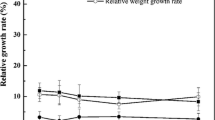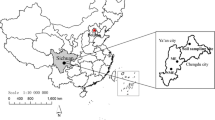Abstract
The effects of increasing concentrations of lead (Pb) on Pb accumulation, subcellular distribution, ultrastructure, photosynthetic characteristics, antioxidative enzyme activity, malondialdehyde content, and phytochelatin contents were investigated in Neyraudia reynaudiana seedlings after a 21-day exposure. A Pb analysis at the subcellular level showed that the majority of Pb in the roots was associated with the cell wall fraction, followed by the soluble fraction. In contrast, the majority of the Pb in the leaves was located in the soluble fraction based on transmission electron microscopy and energy dispersive X-ray analyses. Furthermore, high Pb concentrations adversely affected N. reynaudiana cellular structure. The changes in enzyme activity suggested that the antioxidant system plays an important role in eliminating or alleviating Pb toxicity, both in the roots and leaves of N. reynaudiana. Additionally, the phytochelatin contents in the roots and leaves differed significantly between Pb-spiked treatments and control plants. Our results provide strong evidence that cell walls restrict Pb uptake into the protoplasm and establish an important protective barrier. Subsequent vacuolar compartmentalization in leaves could isolate Pb from other substances in the cell and minimize Pb toxicity in other organelles over time. These results also demonstrated that the levels of antioxidant enzymes and phytochelatin in leaves and roots are correlated with Pb toxicity. These detoxification mechanisms promote Pb tolerance in N. reynaudiana.






Similar content being viewed by others
References
Aebi H, (1984):Catalase in vitro. In: Lester, P. (Ed.). Methods in enzymology. Academic Press, pp. 121–126
Andersen HR, Nielsen JB, Nielsen F, Grandjean P (1997) Antioxidative enzyme activities in human erythrocytes. Clin Chem 43:562–568
Andra SS, Datta R, Sarkar D, Makris KC, Mullens CP, Sahi SV, Bach SB (2010) Synthesis of phytochelatins in vetiver grass upon lead exposure in the presence of phosphorus. Plant Soil 326:171–185
Basile A, Giordano S, Cafiero G, Spagnuolo V, Castaldo-Cobianchi R (1994) Tissue and cell localization of experimentally-supplied lead in Funaria hygrometrica Hedw. Using X-ray SEM and TEM microanalysis. J Bryol 18:69–81
Bibi M, Hussain M (2005) Effect of copper and lead on photosynthesis and plant pigments in black gram [Vigna mungo (L.) Hepper]. B Environ Contam Tox 74:1126–1133
Cheng H, Hu Y (2010) Lead (Pb) isotopic fingerprinting and its applications in lead pollution studies in China: a review. Environ Pollut 158:1134–1146
Dai W, Ning P (2008) Tolerance and accumulation of Neyraudia reynaudiana for Pb. Chinese Journal Of Environmental Engineering 2:1004–1008
De Vos CR, Vonk MJ, Vooijs R, Schat H (1992) Glutathione depletion due to copper-induced phytochelatin synthesis causes oxidative stress in Silene cucubalus. Plant Physiol 98:853–858
Estrella-Gómez N, Mendoza-Cózatl D, Moreno-Sánchez R, González-Mendoza D, Zapata-Pérez O, Martínez-Hernández A, Santamaría JM (2009) The Pb-hyperaccumulator aquatic fern Salvinia minima Baker, responds to Pb 2+ by increasing phytochelatins via changes in SmPCS expression and in phytochelatin synthase activity. Aquat Toxicol 91:320–328
Fu X, Dou C, Chen Y, Chen X, Shi J, Yu M, Xu J (2011) Subcellular distribution and chemical forms of cadmium in Phytolacca americana L. J Hazard Mater 186:103–107
Gill SS, Khan NA, Tuteja N (2012) Cadmium at high dose perturbs growth, photosynthesis and nitrogen metabolism while at low dose it up regulates sulfur assimilation and antioxidant machinery in garden cress (Lepidium sativum L.). Plant Sci 182:112–120
Gupta DK, Huang HG, Yang XE, Razafindrabe BHN, Inouhe M (2010) The detoxification of lead in Sedum alfredii H. is not related to phytochelatins but the glutathione. J Hazard Mater 177:437–444
Huang JW, Chen J, Berti WR, Cunningham SD (1997) Phytoremediation of lead-contaminated soils: role of synthetic chelates in lead phytoextraction. Environ Sci Technol 31:800–805
Huang H, Gupta DK, Tian S, Yang X, Li T (2012) Lead tolerance and physiological adaptation mechanism in roots of accumulating and non-accumulating ecotypes of Sedum alfredii. Environ Sci Pollut R 19:1640–1651
Islam E, Liu D, Li T, Yang X, Jin X, Mahmood Q, Tian S, Li J (2008) Effect of Pb toxicity on leaf growth, physiology and ultrastructure in the two ecotypes of Elsholtzia argyi. J Hazard Mater 154:914–926
Kopittke PM, Asher CJ, Blamey FPC, Auchterlonie GJ, Guo YN, Menzies NW (2008) Localization and chemical speciation of Pb in roots of signal grass (Brachiaria decumbens) and Rhodes grass (Chloris gayana). Environ Sci Technol 42:4595–4599
Kosobrukhov A, Knyazeva I, Mudrik V (2004) Plantago major plants responses to increase content of lead in soil: growth and photosynthesis. Plant Growth Regul 42:145–151
Li X, Zhang L, Li Y, Ma L, Bu N, Ma C (2012) Changes in photosynthesis, antioxidant enzymes and lipid peroxidation in soybean seedlings exposed to UV-B radiation and/or Cd. Plant Soil 352:377–387
Li Y, Zhou C, Huang M (2016) Lead tolerance mechanism in Conyza canadensis: subcellular distribution, ultrastructure, antioxidative defense system, and phytochelatins. J Plant Res 129(2):251–262
Lichtenthaler HK, Buschmann C(2001). Chlorophylls and carotenoids: measurement and characterization by UV-VIS spectroscopy. Current protocols in food analytical chemistry
Liu J, Mei C, Cai H, Wang M (2015) Relationships between subcellular distribution and translocation and grain accumulation of Pb in different rice cultivars. Water Air Soil Pollut 226:1–9
Ma JF, Ueno D, Zhao F, McGrath SP (2005) Subcellular localisation of Cd and Zn in the leaves of a Cd-hyperaccumulating ecotype of Thlaspi caerulescens. Planta 220:731–736
Małecka A, Piechalak A, Morkunas I, Tomaszewska B (2008) Accumulation of lead in root cells of Pisum sativum. Acta Physiol Plant 30:629–637
Mingorance MD, Leidi EO, Valdés B, Oliva SR (2012) Evaluation of lead toxicity in Erica andevalensis as an alternative species for revegetation of contaminated soils. Int J Phytoremediat 14:174–185
Mishra S, Srivastava S, Tripathi RD, Kumar R, Seth CS, Gupta DK (2006) Lead detoxification by coontail (Ceratophyllum demersum L.) involves induction of phytochelatins and antioxidant system in response to its accumulation. Chemosphere 65:1027–1039
Nishizono H, Ichikawa H, Suziki S, Ishii F (1987) The role of the root cell wall in the heavy metal tolerance of Athyrium yokoscense. Plant Soil 101:15–20
Patra J, Lenka M, Panda BB (1994) Tolerance and co-tolerance of the grass Chloris barbata Sw. to mercury, cadmium and zinc. New Phytol 128:165–171
Pourrut B, Shahid M, Dumat C, Winterton P, Pinelli E (2011) Lead uptake, toxicity, and detoxification in plants. R Environ Contam Toxico 213:113–136
Qiao X, Zheng Z, Zhang L, Wang J, Shi G, Xu X (2015) Lead tolerance mechanism in sterilized seedlings of Potamogeton crispus L.: subcellular distribution, polyamines and proline. Chemosphere 120:179–187
Salazar MJ, Pignata ML (2014) Lead accumulation in plants grown in polluted soils. Screening of native species for phytoremediation. J Geochem Explor 137:29–36
Sharma P, Dubey RS (2005) Lead toxicity in plants. Braz J Plant Physiol 17:35–52
Srinivasan M, Vikram SS, Favas PJ, Perumal V (2014) Lead heavy metal toxicity induced changes on growth and antioxidative enzymes level in water hyacinths [Eichhornia crassipes (Mart.)]. Bot Stud 55:1–11
Sytar O, Kumar A, Latowski D, Kuczynska P, Strzałka K, Prasad M (2013) Heavy metal-induced oxidative damage, defense reactions, and detoxification mechanisms in plants. Acta Physiol Plant 35:985–999
Tian S, Lu L, Yang X, Webb SM, Du Y, Brown PH (2010) Spatial imaging and speciation of lead in the accumulator plant Sedum alfredii by microscopically focused synchrotron X-ray investigation. Environ Sci Technol 44:5920–5926
Verma S, Dubey RS (2003) Lead toxicity induces lipid peroxidation and alters the activities of antioxidant enzymes in growing rice plants. Plant Sci 164:645–655
Wang S, Zhang J (2006) Blood lead levels in children, China. Environ Res 101:412–418
Wu Z, McGrouther K, Chen D, Wu W, Wang H (2013) Subcellular distribution of metals within Brassica chinensis L. in response to elevated lead and chromium stress. J Agr Food Chem 61:4715–4722
Zhao L, Li T, Yu H, Chen G, Zhang X, Zheng Z, Li J (2015) Changes in chemical forms, subcellular distribution, and thiol compounds involved in Pb accumulation and detoxification in Athyrium wardii (Hook.). Environ Sci Pollut R, 1–13.
Zhou CF, Wang Y, Li C, Sun R, Yu Y, Zhou D (2013) Subacute toxicity of copper and glyphosate and their interaction to earthworm ( Eisenia fetida). Environ Pollut 180:71–77
Zhou CF, Wang YJ, Sun RJ, Liu C, Fan GP, Qin WX, Li CC, Zhou DM (2014) Inhibition effect of glyphosate on the acute and subacute toxicity of cadmium to earthworm Eisenia fetida. Environ Toxicol Chem 33:2351–2357
Zhou CF, Zhang K, Lin J, Li Y, Chen N, Zou X, Hou X, Ma X (2015) Physiological responses and tolerance mechanisms to cadmium in Conyza canadensis. Int J Phytoremediat 17:280–289
Acknowledgments
This work was supported by the National Key Technology Support Program (2014BAD15B02), Foundation for Cultivation Plan of Distinguished Young Scholars of Fujian Province (2005), National Natural Science Foundation of China (31400465, 41401364), National Natural Science Foundation of Fujian (2013J01073).
Author information
Authors and Affiliations
Corresponding author
Additional information
Responsible editor: Hailong Wang
Electronic supplementary material
ESM 1
(DOCX 127 kb)
Rights and permissions
About this article
Cite this article
Zhou, C., Huang, M., Li, Y. et al. Changes in subcellular distribution and antioxidant compounds involved in Pb accumulation and detoxification in Neyraudia reynaudiana . Environ Sci Pollut Res 23, 21794–21804 (2016). https://doi.org/10.1007/s11356-016-7362-1
Received:
Accepted:
Published:
Issue Date:
DOI: https://doi.org/10.1007/s11356-016-7362-1




